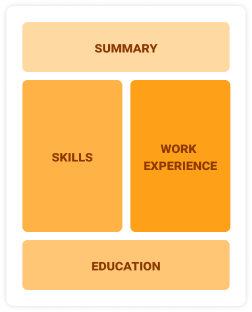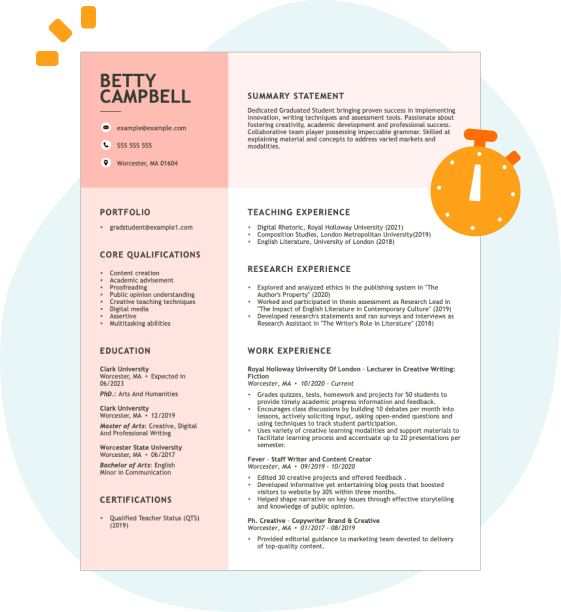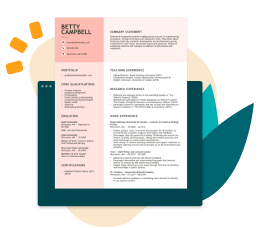Hard skills are technical abilities like data analysis, experimental design, and laboratory techniques that are essential for conducting rigorous research.
Popular Research Scientist Resume Examples
Check out our top research scientist resume examples that demonstrate key skills such as data analysis, experimental design, and critical thinking. These examples will help you effectively showcase your contributions to the scientific community.
Looking to build your impressive resume? Our Resume Builder offers user-friendly templates specifically created for research professionals, making it simple to highlight your expertise.
Entry-level research scientist resume
This entry-level resume effectively showcases the job seeker's technical skills and accomplishments in data science, machine learning, and research methodologies.
New professionals must demonstrate their ability to deliver powerful results through projects and publications, highlighting relevant academic achievements and practical experiences even with limited work history.
Mid-career research scientist resume
This resume effectively showcases the applicant's qualifications by highlighting leadership in research and a strong publication record. The clear presentation of responsibilities and accomplishments illustrates readiness for advanced roles, emphasizing significant contributions to AI and data science.
Experienced research scientist resume
The work experience section demonstrates the applicant's strong background in research, particularly in AI model development and team leadership. Key achievements include improving model accuracy by 20% and publishing 10 influential papers, while the clear formatting allows hiring managers to quickly identify critical contributions.
Resume Template—Easy to Copy & Paste
Yuki Chen
Los Angeles, CA 90005
(555)555-5555
Yuki.Chen@example.com
Professional Summary
Accomplished Research Scientist with expertise in data science and analytics, Published over dozen papers with significant contributions to industry research methodologies. Proven ability to improve efficiency and develop groundbreaking solutions.
Work History
Research Scientist
AI Research Lab - Los Angeles, CA
January 2023 - December 2025
- Published 12 peer-reviewed papers.
- Led project increasing efficiency by 25%.
- Analyzed data sets improving accuracy by 30%.
Data Analyst
Quantified Insights Corp - Lakeside, CA
January 2019 - December 2022
- Developed models reducing costs by K.
- Optimized database queries by 40%.
- Implemented dashboard increasing reporting speed.
Junior Research Associate
Tech Innovators Hub - Lakeside, CA
January 2016 - December 2018
- Conducted experiments enhancing methods.
- Collaborated on team projects improving outputs.
- Synthesized findings into reports for stakeholders.
Skills
- Quantitative Analysis
- Machine Learning
- Statistical Modeling
- Data Visualization
- Research Methodologies
- Programming in Python
- Problem Solving
- Data Mining
Certifications
- Certified Data Scientist - Data Science Institute
- Advanced Research Techniques - National Science Academy
Education
Master's Data Science
University of California, Berkeley Berkeley, CA
December 2015
Bachelor's Computer Science
University of New York New York, NY
December 2012
Languages
- Spanish - Beginner (A1)
- German - Intermediate (B1)
- Japanese - Beginner (A1)
How to Write a Research Scientist Resume Summary
Your resume summary is important as it's the first thing potential employers will see, setting the tone for your application. Make sure it captures their attention by showcasing your expertise and passion for research.
As a research scientist, focus on highlighting your analytical skills, innovative thinking, and any significant contributions to scientific knowledge. These elements are key in demonstrating your value to potential employers.
Reviewing examples of research scientist resume summaries will help you understand what stands out and what may need improvement. Let's dive into these examples:
Weak resume summary
I am a dedicated research scientist with many years of experience conducting experiments and analyzing data. I hope to find a position that allows me to apply my skills while working in a collaborative environment. A role where I can contribute to innovative projects is what I seek, and I believe I would be a great asset if given the chance.
- Lacks specific achievements or expertise related to research, making it too general
- Overly focuses on personal desires instead of what value the job seeker brings to potential employers
- Uses ambiguous language that fails to convey confidence or unique qualifications
Strong resume summary
Results-driven research scientist with over 7 years of experience in molecular biology and genetics, focusing on cancer research. Successfully led a team that published findings in a high-impact journal, contributing to a 30% increase in grant funding for ongoing studies. Proficient in CRISPR technology, data analysis using R, and managing cross-functional collaborations to drive innovative research outcomes.
- Begins with specific years of experience and area of expertise
- Highlights a quantifiable achievement that showcases the impact on research funding and publication success
- Mentions relevant technical skills that align with current industry standards and employer expectations
PRO TIP
Showcasing Your Work Experience
The work experience section is an important part of your resume as a research scientist, where you'll present the bulk of your qualifications. Good resume templates will always emphasize this section to showcase your professional journey.
This area should be arranged in reverse-chronological order, listing your previous positions clearly. Use bullet points to detail specific achievements and contributions you made in each role, highlighting your expertise.
To further illustrate how to craft an effective work history section, we’ve prepared a couple of examples for you. These examples will clarify what stands out and what should be avoided.
Research Scientist
Global Research Institute – New York, NY
- Conducted experiments.
- Analyzed data using software.
- Collaborated with team members.
- Prepared reports and presentations.
- Lacks specifics about the research focus or projects worked on
- Bullet points are vague and do not highlight any significant contributions or results
- Emphasizes routine tasks rather than achievements that demonstrate expertise or impact
Research Scientist
Innovative Labs – San Francisco, CA
March 2020 - Present
- Lead a team in developing novel drug compounds, achieving a 30% increase in efficacy compared to previous benchmarks.
- Publish findings in peer-reviewed journals, contributing to the scientific community and improving the company's reputation.
- Optimize laboratory protocols that reduced experimental errors by 15%, streamlining research processes.
- Starts each bullet with effective action verbs highlighting the applicant's contributions
- Incorporates specific metrics to illustrate achievements clearly
- Highlights relevant skills such as leadership and optimization of processes that are critical for research scientists
While your resume summary and work experience sections are important, don’t overlook the significance of other components that can improve your application. Each section deserves careful attention to detail. For more insights, check out our complete guide on how to write a resume.
Top Skills to Include on Your Resume
A well-defined skills section is important for any effective resume. It provides a snapshot of your qualifications skills, helping potential employers quickly assess your fit for the research scientist role.
Every resume should have a mix of hard skills and soft skills. Including a diverse range of relevant skills will make your application much stronger.
Soft skills, such as critical thinking, collaboration, and effective communication, play a important role in fostering teamwork and ensuring that research findings are clearly shared with the scientific community and stakeholders.
Selecting the right resume skills is important for standing out in a competitive job market. Employers often seek applicants who not only meet their expectations but also fit through automated screening systems that filter out unqualified applicants.
To ensure your resume catches attention, review job postings carefully. They provide valuable insights into which skills to highlight, making it easier for both recruiters and ATS to recognize your qualifications.
PRO TIP
10 skills that appear on successful research scientist resumes
To attract recruiters' attention, it’s essential to highlight high-demand skills relevant to research scientist roles. These skills can be seen in our resume examples, empowering you to apply with confidence and professionalism.
Here are 10 skills you should consider including in your resume if they align with your experience and job needs:
Analytical thinking
Data interpretation
Technical writing
Experimentation techniques
Statistical analysis
Project management
Collaboration and teamwork
Attention to detail
Problem-solving abilities
Knowledge of laboratory safety
Based on analysis of 5,000+ sciences professional resumes from 2023-2024
Resume Format Examples
Selecting the appropriate resume format is important for a research scientist because it effectively highlights your technical skills, relevant experiences, and professional growth in the field.
Functional
Focuses on skills rather than previous jobs

Best for:
Recent graduates and career changers with little to no experience
Combination
Balances skills and work history equally

Best for:
Mid-career scientists showcasing expertise and seeking continued growth opportunities
Chronological
Emphasizes work history in reverse order

Best for:
Experts leading innovative research projects in specialized fields
Research Scientist Salaries in the Highest-Paid States
Our research scientist salary data is based on figures from the U.S. Bureau of Labor Statistics (BLS), the authoritative source for employment trends and wage information nationwide.
Whether you're entering the workforce or considering a move to a new city or state, this data can help you gauge what fair compensation looks like for research scientists in your desired area.
Frequently Asked Questions
Should I include a cover letter with my research scientist resume?
Absolutely. Including a cover letter can significantly improve your application by showcasing your enthusiasm and detailing how your skills align with the job. If you're looking for guidance, our comprehensive resources on how to write a cover letter are available to help you craft one that makes an impact.
Additionally, you can use our Cover Letter Generator to streamline the process and create a professional document effortlessly.
Can I use a resume if I’m applying internationally, or do I need a CV?
For international job applications, a CV is often preferred over a resume due to its comprehensive nature. It’s essential for showcasing academic qualifications and detailed work history.
To ensure your application meets employers' expectations worldwide, explore how to write a CV and see various CV examples for guidance on formatting and creation.
What soft skills are important for research scientists?
Soft skills such as collaborative problem-solving, critical thinking, and clear communication are important for research scientists. These interpersonal skills foster effective teamwork, improve innovation, and facilitate the successful sharing of complex ideas with diverse audiences.
I’m transitioning from another field. How should I highlight my experience?
Highlight your transferable skills such as analytical thinking, teamwork, and project management. These abilities demonstrate your potential to thrive in research science roles, even if your background is outside this field.
Share specific instances where you successfully solved complex problems or collaborated on projects to illustrate how your past experiences align with the responsibilities of a research scientist.
Where can I find inspiration for writing my cover letter as a research scientist?
For aspiring research scientists, exploring professional cover letter examples can be invaluable. These samples not only offer content ideas but also serve as a guide for effective formatting. By examining how others highlight their qualifications, you can create a compelling narrative that sets your application apart.
Should I include a personal mission statement on my research scientist resume?
Including a personal mission statement in your resume can effectively convey your commitment to innovation and research goals. This approach is especially compelling when you apply to organizations with a strong research focus or mission-driven ethos.







